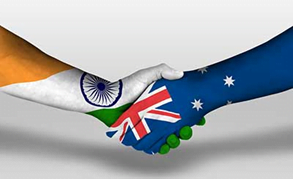International Relations
Context: Recently, the Australian parliament ratified the India-Australia free trade agreement, the Economic Cooperation and Trade Agreement (ECTA).
About Free Trade Agreement (FTA):
- A free trade agreement is an agreement in which two or more countries agree to provide preferential trade terms, tariff concession etc. to the partner country.
- India has negotiated FTA with many countries and trade blocs e.g., Sri Lanka, Singapore, ASEAN etc.
About India- Australia ECTA:

- The Agreement encompasses cooperation across the entire gamut of bilateral economic and commercial relations between the two countries and covers areas such as:
- Trade in Goods and services, Rules of Origin
- Technical Barriers to Trade (TBT), sanitary and Phytosanitary (SPS) measures.
- Dispute Settlement, Movement of Natural Persons.
- Telecom, Customs Procedures, Pharmaceutical products, and Cooperation in other Areas.
- ECTA provides for an institutional mechanism to encourage and improve trade between the two countries and covers almost all the tariff lines.
- Zero duty benefits on 98.3% of Australian tariff lines, from the day the agreement comes into force, will be extended to all Indian products within five years.
- Australia, in turn, will get zero duty benefits for 90% of its exports (in value terms) to India.
- Under the agreement, Indian graduates from STEM (Science, Technology, Engineering and Mathematics) will be granted extended post-study work visas.
- Australia will also set up a programme to grant visas to young Indians looking to pursue working holidays in Australia.
- Annual Visa quota of 1800 is to be instituted for India Yoga teachers and Chefs.
Evolution of India- Australia relations over time:
India-Australia bilateral trade at a glance:
- Australia is the 17th largest trading partner to India and India is Australia’s 9th largest trading partner.
- In 2021-22, India’s goods exports to Australia valued US$8.3 billion and imports were about US$16.7 billion.
- Two-way trade in goods and services in 2020 was valued at US$24.3 billion.
- India’s merchandise exports to Australia grew 135 percent between 2019 and 2021.
- India’s exports consist primarily of a broad-based basket largely of finished products.
- Around 96 percent of Australia’s exports are raw materials and intermediate products.
Bipartisan support in the backdrop China factor:
- India-Australia partnership enjoys wide, bipartisan support in Australia because Australia has been particularly upset with what it called the ‘weaponization of trade’ by China.
- It has surely helped galvanize sentiment about India being a more trustworthy partner.
Shared interests and new partnerships:
- The two countries are already part of recently formed global cliques such as the four-nation Quad, the trilateral Supply Chain Resilience Initiative and the Indo-Pacific Economic Forum (IPEF).
- Both the countries are facing an assertive China challenge which brings the two countries together for converged interests.
Strong ties and democracy:
- Both the countries have been part of the Commonwealths and are among the prominent democracies which make them likable partners.
New opportunities:
- The bilateral trade deal is a strong positive signal about India’s credentials to a world shuffling its feet away from dodgy supply chains towards a ‘China plus one’ strategy.
Impact of the Economic Cooperation and Trade Agreement (ECTA):
- India expects bilateral trade to rise to about $50 billion from the current level of $31 billion in five years, with Indian exports driving half this surge.
- India hopes to increase its merchandise exports by US$10 billion by 2026-27.
- The ECTA will create a million new jobs in labour-intensive sectors Gems and Jewellery, Textiles, leather, footwear, furniture etc.
- Raw materials such as coal, metals and wool dominate Australia’s export shipments meaning cheaper inputs for Indian firms.
- The approval of a double taxation avoidance agreement by Australia, which is expected to save millions of dollars a year for Indian IT firms.
Way Forward:
- The new age free trade agreements are based on reciprocal economic benefits and enhanced trade facilitation ,India can resort to ways which will facilitate smoother trade
- India needs to improve the efficiency of ports, shipping, Customs, etc., via automation which would be a big boost for participation by MSMEs.
- Developing alternative sources of supply in which all the components are available in vicinity and locally.
- India must look at a hybrid model to source from the most efficient suppliers, including domestic players.
- The new-age FTAs demand more holistic and diversified trade opportunities with trade in services, e-commerce, labour, climate/environment, digital trade, public procurement, supply chains etc.
Although, the India-Australia ECTA will further cement the already deep, close and strategic relations between the two countries and will significantly enhance bilateral trade. It is critical to remember that trade deals open new doors, but do not automatically mean higher exports or better trade balances, as India’s past pacts with ASEAN and Japan have shown.
There is no shortcut or alternative to fixing India’s overall global competitiveness and the policy makers and other stakeholders need to take a leap forward to improve India’s competitiveness to secure India’s interests.
MUST READ: India – Australia Relations
Source: The Hindu














